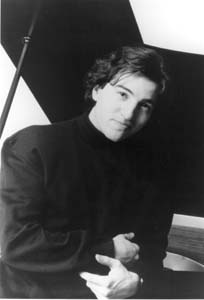![[Metroactive Music]](/music/gifs/music468.gif)
[ Music Index | San Jose | Metroactive Central | Archives ]
 On the 'Nights' Shift: Pianist Fazil Say delivered a competent turn on the de Falla.
On the 'Nights' Shift: Pianist Fazil Say delivered a competent turn on the de Falla.
Photograph by Christian Steiner
Pouring on the Brass SJ Symphony's Copland choice looked better in print than it sounded on stage By Scott MacClelland LAST SATURDAY'S performance by the San Jose Symphony showed more tarnish than the orchestra typically does. Leonid Grin's reading of Aaron Copland's Symphony No. 3 allowed too many cracked brass notes to go unnoticed and, in its third movement, found the violin ensemble both out of tune and insecure at exposed entrances. The root cause may have lain in the programming, which looked better in print than it sounded in concert. Despite its reworking of the popular Fanfare for the Common Man, Copland's third symphony is the least interesting and most self-conscious of any work he called symphony (including the Organ, Short and Dance.) It is also his most overwrought, as bombastic as the hair-raising Organ symphony, but far less original and consistent. The first movement pours on the brass in loud, embouchure-bruising choruses, barely pausing for any artistic touches. The final movement hammers the Fanfare theme into the ground before introducing the material that will later play in counterpoint--sort of--when the fanfare returns. When it does, Copland belabors it again at the highest volume as if to conceal a flagging imagination behind the oldest audience-rousing trick in the book. The work is at its best in the second movement, which restores the finesse, transparency and signature Copland sound in high, confident style. The third movement also contains moments of arresting originality. Nevertheless, it does have its fans, and from the look of it, most of them occupied the Center for the Performing Arts for the event. In contrast, Manuel de Falla's Nights in the Gardens of Spain made a curiously absentminded introduction to it, a spell of subtle impressionism before a blaring onslaught. On the downside, the piano in Nights is an orchestral rather than solo voice, denying any realistic expectation of virtuoso display, per se. For this reason, it wastes an opportunity to give its soloist a true introduction. Fazil Say played a competent performance, well spoken on orchestral terms but hardly enough to etch a lasting impression of his artistry. On the upside, the work presents a gorgeous tapestry of shimmering colors and glowing timbres. In its reading, the orchestra perfumed the air with the nectar of blossoms on a warm summer night. But even when the piano rises above the orchestra for flamenco allusions (with parallel octaves and pregnant cadences) in the last movement, Falla never gives it anything that could be called piano literature. In the context, one of the Shostakovich piano concertos would have benefited both the soloist and ensuing Copland. Then again, Copland's Organ symphony would also have been a better choice. IF CARLOS CHAVEZ' Sinfonia India was shocking when first heard in the 1930s, today it sounds more like a postcard from colonial Mexico. It decorates classical formal procedures with exotic percussion and woodwind effects. Its form never loses clarity, and its sections are discrete, including a boisterous, high-speed final dance. (The latter would be imitated by Ginastera in his Malambo.) Revueltas' Sensemayà on the opposite hand starts with Stravinsky's Rite of Spring, a brooding, primitivistic intonation sulking with ostinatos and ominous currents. In fact, the composer staked his claim here to an Afro-Cuban energy that, while honored by the aristocratic Chavez (who conducted its premiere in 1938), was never taken up by him in his own music. Sensemayà is impulsive music, following its own drum, unkempt and menacing. Conductor Grin made clean, clear work of the Chavez but held the reins too tightly to let fire emerge from the dark Revueltas. The orchestra sparkled in the former and growled in the latter. [ San Jose | Metroactive Central | Archives ]
|
From the January 13-19, 2000 issue of Metro, Silicon Valley's Weekly Newspaper.
Copyright © 1999 Metro Publishing Inc. Metroactive is affiliated with the Boulevards Network.
For more information about the San Jose/Silicon Valley area, visit sanjose.com.